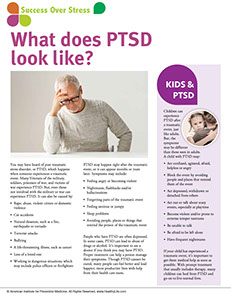SYMPTOM CHECKER
CONDITIONS
Male
Female
Child
Arm, Hand & Shoulder Concerns
Legs & Feet Concerns
Dental & Mouth Concerns
Ear & Nose
Eye Conditions
Head Conditions
Arm, Hand & Shoulder Concerns
Legs & Feet Concerns
Front
Back
Arm, Hand & Shoulder Concerns
Dental & Mouth Concerns
Ear & Nose
Eye Conditions
Head Conditions
Arm, Hand & Shoulder Concerns
Dental & Mouth Concerns
Ear & Nose
Eye Conditions
Head Conditions
Front
Back
Arm, Hand & Shoulder Concerns
Neck Links
Head & Neck Concerns
Arm, Hand & Shoulder Concerns
Neck Links
Head & Neck Concerns
Front
Back
Online Clinic
Wise Healthcare
What does PTSD look like?

Print on Demand
You may have heard of post-traumatic stress disorder, or PTSD, which happens when someone experiences a traumatic event. Many Veterans of the military, soldiers, prisoners of war, and victims of war experience PTSD. But, even those not involved with the military or war can experience PTSD. It can also be caused by:
• Rape, abuse, violent crimes or domestic violence
• Car accidents
• Natural disasters, such as a fire, earthquake or tornado
• Terrorist attacks
• Bullying
• A life-threatening illness, such as cancer
• Loss of a loved one
• Working in dangerous situations, which may include police officers or firefighters
PTSD may happen right after the traumatic event, or it can appear months or years later. Symptoms may include:
• Feeling angry or becoming violent
• Nightmares, flashbacks and/or hallucinations
• Forgetting parts of the traumatic event
• Feeling anxious or jumpy
• Sleep problems
• Avoiding people, places or things that remind the person of the traumatic event
People who have PTSD are often depressed. In some cases, PTSD can lead to abuse of drugs or alcohol. It’s important to see a doctor if you think you may have PTSD. Proper treatment can help a person manage their symptoms. Though PTSD cannot be cured, many people can feel better and lead happier, more productive lives with help from their health care team.
Kids & PTSD
Children can experience PTSD after a traumatic event, just like adults. But, the symptoms may be different than those seen in adults. A child with PTSD may:
• Act confused, agitated, afraid, helpless or angry
• Block the event by avoiding people and places that remind them of the event
• Act depressed, withdrawn or detached from others
• Act out or talk about scary events, especially at playtime
• Become violent and/or prone to extreme temper tantrums
• Be unable to talk
• Be afraid to be left alone
• Have frequent nightmares
If your child has experienced a traumatic event, it’s important to get them medical help as soon as possible. With prompt treatment that usually includes therapy, many children can heal from PTSD and go on to live normal lives.
This website is not meant to substitute for expert medical advice or treatment. Follow your doctor’s or health care provider’s advice if it differs from what is given in this guide.
The American Institute for Preventive Medicine (AIPM) is not responsible for the availability or content of external sites, nor does AIPM endorse them. Also, it is the responsibility of the user to examine the copyright and licensing restrictions of external pages and to secure all necessary permission.
The content on this website is proprietary. You may not modify, copy, reproduce, republish, upload, post, transmit, or distribute, in any manner, the material on the website without the written permission of AIPM.
2021 © American Institute for Preventive Medicine - All Rights Reserved. Disclaimer | www.HealthyLife.com
















































